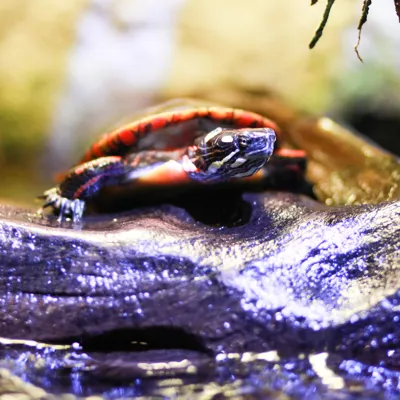
Meet our Turtles!
Known to be direct descendants of dinosaurs, turtles are one of our biggest captivations, with some having been rescued and rehabilitated in this habitat. Learn everything about turtles, including their feeding habits and inability to draw their heads and legs into their shells, at our displays. Visit and meet our turtles, which include:
- Ted, the Loggerhead sea turtle, was voted as Orlando's most-loved creature: Oh! - he will be featured on a Frontier Airlines plane
- Chely, the green sea turtle who is a boat strike rescue and;
- Terrapin turtles
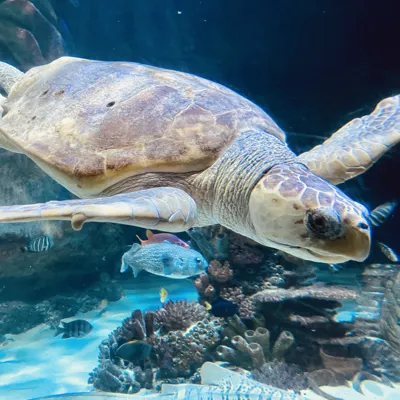
Ted the Loggerhead Sea Turtle
As a baby, Ted was one of the first turtles to test the Turtle Excluder Device (get it? T.E.D.!) which was developed to protect sea turtles from getting caught in fishing nets. Researchers tried to release Ted back to the wild several times, but he kept coming back to shore to visit his human friends! Ted has been with us at SEA LIFE Orlando Aquarium since 2016 and loves meeting all of the nice humans who come to our attraction!
Ted was voted Orlando's Most-Loved Animal (thanks to all of you!) and he has been featured on a Frontier Airlines plane! When Ted was notified of his big win, he made sure to prepare an acceptance speech to thank all of his supporters. Check out his plane reveal here!
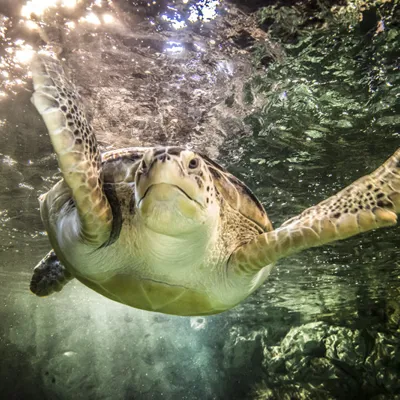
Chely the Green Sea Turtle
Chely came to us after a boat strike caused a crack in his shell. Because of this crack, Chely has trouble with buoyancy, meaning it's hard for him to swim deep under the water. Luckily, Chely still loves to swim and works with our aquarists to practice diving deep in his tank to strengthen his muscles! His favorite snack is lettuce, so our aquarists put lettuce at the bottom of the tank to encourage him to stay deeper in the water.
Speaking of diving, did you know green sea turtles can hold their breath for up to five hours? Chely loves to show off just how long he can stay underwater before coming up for air!
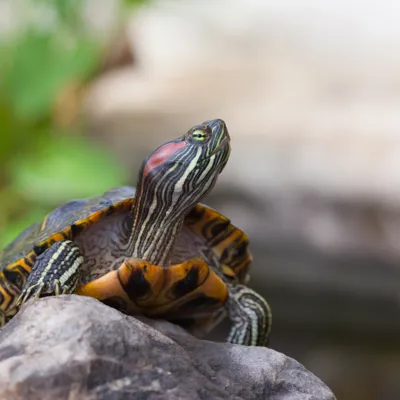
Terrapins
In essence, terrapins are freshwater turtles endemic to brackish habitats. They are relatively small in size. Terrapins regularly swim but also spend time on land basking and burrowing in the mud.
Terrapins have a hard, slightly domed shell similar to that of tortoises and have legs instead of flippers, unlike sea turtles; they seem to be a mix of the turtle and tortoise. They are omnivorous, and their dietary preferences comprise algae, aquatic plants, small fish, insects, and crustaceans.
At SEA LIFE Orlando Aquarium, you will find the terrapins lying on the rocks soaking up the heat in their tanks any time you visit. Enjoy the charm of these magnificent animals and learn more about their anatomy and behavior.
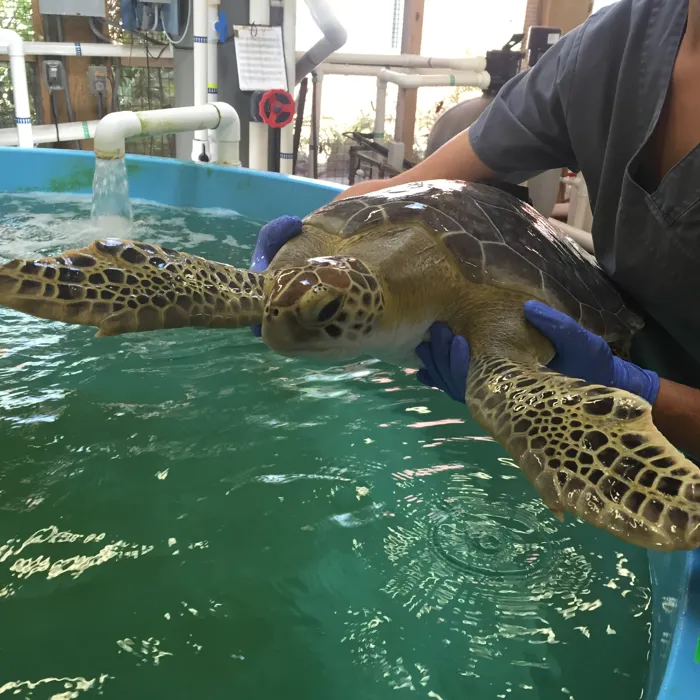
Sea Turtle Rescue and Conservation
Sea turtles worldwide are faced with unique dangers that have threatened them to near extinction, such as:
- Entanglement in fishing gear and fishing boat incidents
- Plastics and marine debris
- Illegal consumption and predators
- Global warming
- Developments along their coastal habitat and nesting grounds
As a result, sea turtles list among the world's most endangered species, and awareness about the need to rescue them has been a topic of discussion globally. In an effort to ensure their conservation, the IUCN has itemized sea turtles at the top of its list of vulnerable and endangered species.
Efforts to rescue and enable the conservation of sea turtles is reinforced by reporting any sightings of stranded turtles. This work is mainly carried out by non-profit organizations, mandated government agencies, and dedicated marine biologists across the globe. These teams identify the causes of stranding, document apparent wounds, and move the injured or sick sea turtles to rehabilitation centers for care. Public education on the importance of sea turtle conservation is key to ensuring their survival.
Sea turtles are more vulnerable during winter when the temperatures drop, and most are stranded once washed ashore, either dead or alive. Winter exposes them to a phenomenon called cold stunning, which decreases their heart rate, causing them to become lethargic, leading to frostbite, pneumonia, or death.
When rescued, the stranded sea turtles are transported to listed rehabilitation facilities where they are observed, placed in dry tubs, treated, and in some instances later released back into the ocean once the weather becomes favorably warmer.
At SEA LIFE, we promote turtle rescue and conservation measures through various programs aimed at educating the public and raising awareness at our facility. At SEA LIFE we are dedicated to taking care of rescued sea turtles, whereby we release them back into the wild once they recover or they live with us if they’re deemed not fit to go back in the wild. If the sea turtles require life-long care, we keep them at our aquariums, and provide for their every need.
Visit a sea turtle exhibit near to learn more about how you can play a part in ensuring turtle rescue and conservation.
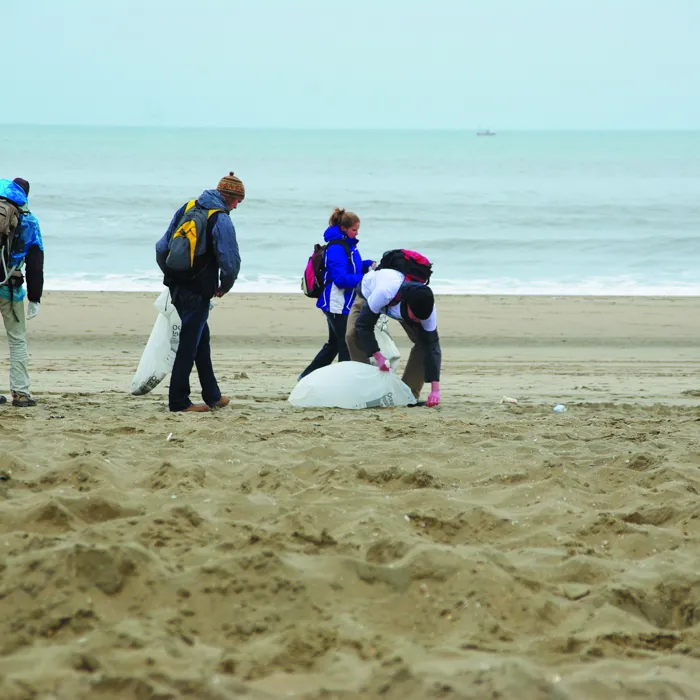
Things People Can Do to Protect Sea Turtle Habitats
To protect the endangered sea turtle, you should choose to be a conscious seafood consumer by opting to buy sea food from suppliers who practice sustainable fishing methods. Other measures include raising awareness of the importance of catching seafood in ways that do not harm the turtles or their habitat.
On that conscious note, ensure:
- You take part in coast and beach clean-ups aimed at reducing trash and plastics that are harmful to the sea turtles and their habitat
- Engage in reducing marine debris
- Remove beach equipment when you leave and fill in holes or sandcastles that may become obstacles in the sea turtles' habitats.
Whenever you come across a stranded sea turtle:
- Keep your distance to avoid disturbing the turtle
- Avoid flash photography or any other bright lights as it might discourage them from nesting
- Warn others not to approach the turtle
- Report to the nearest sea turtle rescue center as soon as possible
Harming or harassing the sea turtles is a federal crime, and it is up to everyone to rescue these endangered creatures to ensure their continued survival.
For more information, visit us with your family, and learn more about our conservation efforts, read more here.
Frequently Asked Questions
The SEA LIFE Orlando Aquarium features two notable turtles: Ted, a Loggerhead sea turtle, and Chely, a green sea turtle who is a boat strike rescue. Each has a unique story, with Ted being voted Orlando’s most-loved animal and featured on a Frontier Airlines plane, and Chely having buoyancy issues due to a cracked shell.
The turtles are special due to their unique histories and conservation significance. Ted was part of testing the Turtle Excluder Device (T.E.D.) and prefers human company, and Chely is a rescue with a buoyancy issue from a boat strike. Their presence educates visitors about ocean conservation.
Yes, visitors can get up close during the Turtle Experience, a 45-minute behind-the-scenes tour at 12:30 PM daily, where they can see Chely, the green sea turtle, during feeding and participate in a Q&A with an aquarist. This tour also supports conservation, with $3 per ticket going to the SEA LIFE Trust.
It might take months or years, depending on the severity of injuries. However, once fully recovered, they are released when the weather is warmer or taken care of for the rest of their natural life.
The turtles are deemed unreleasable due to health issues. Chely has buoyancy problems from a cracked shell caused by a boat strike. Ted, despite multiple release attempts, kept returning to shore, indicating he prefers human interaction. They receive lifelong care at the aquarium.
They are an essential part of both marine and coastal ecosystems. They help uphold the health of seagrass beds and coral reefs. Sea turtles are essential in maintaining the balance in the marine food webs and facilitating nutrient cycling from water to land.